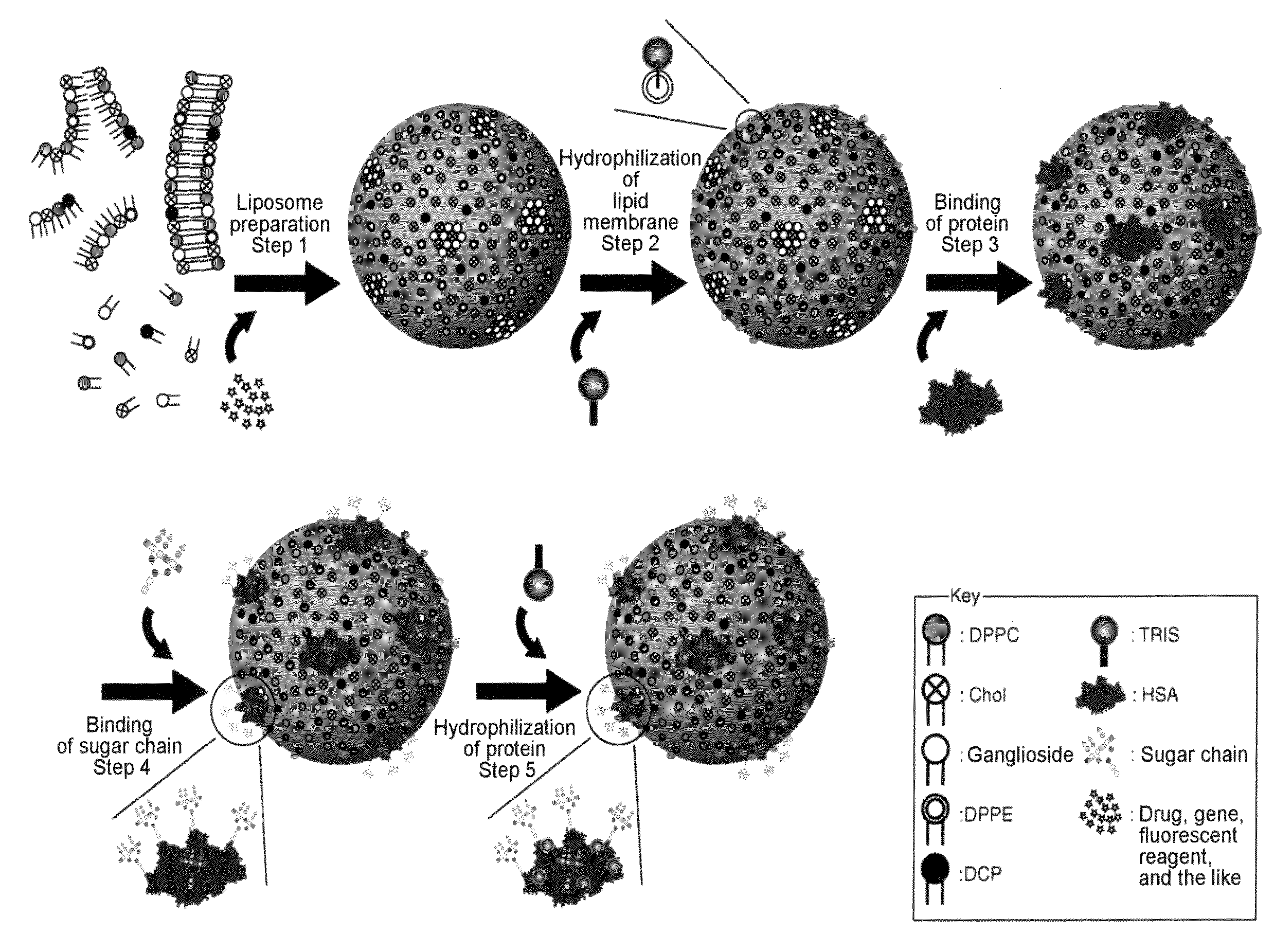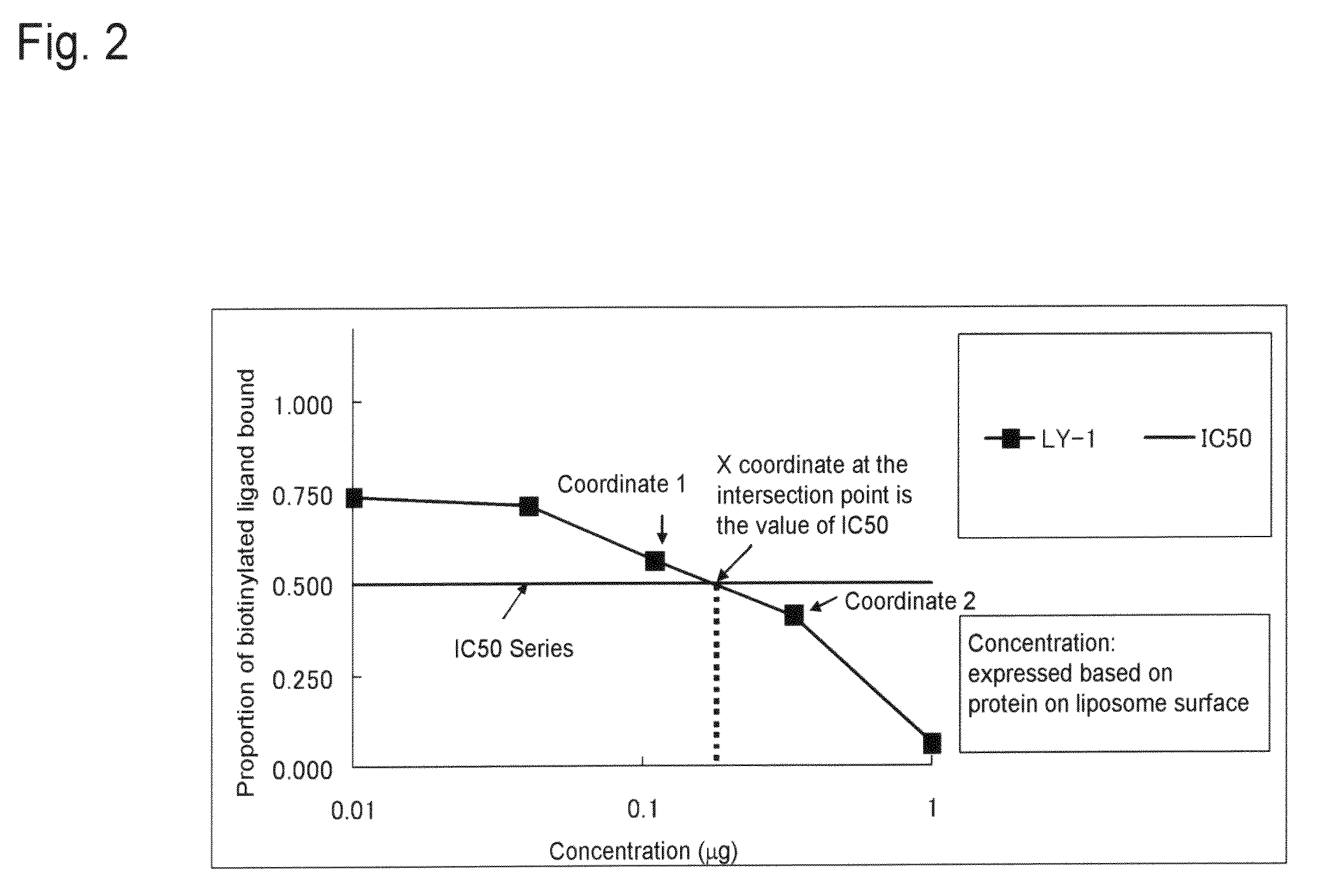Design of Delivery Vehicle Based On Rolling Model
a technology of rolling model and delivery vehicle, applied in the field of design, can solve the problems of insufficient methods, drug acts on undesired sites, and needs further improvement, and achieve the effect of increasing the range of development of a dds formulation
- Summary
- Abstract
- Description
- Claims
- Application Information
AI Technical Summary
Benefits of technology
Problems solved by technology
Method used
Image
Examples
example 3
Binding of Human Serum Albumin (HSA) onto Liposome Membrane Surface
[0347]Human serum albumin (HSA) was bound onto a liposome membrane surface according to the technique of the previous report (Yamazaki, N., Kodama, M. and Gabius, H.-J. (1994) Methods Enzymol. 242, 56-65) using a coupling reaction method. Specifically, the reaction was performed as a two-step chemical reaction. First, ganglioside existing on the membrane surface of 10 ml of the liposome obtained in Example 2 was added to 43 mg of sodium metaperiodate dissolved in 1 ml of a TAPS buffer solution (pH8.4), followed by 2 hours of agitation at room temperature to perform periodate oxidation. The resultant was subjected to ultrafiltration using an XM300 membrane and a PBS buffer solution (pH8.0) so that 10 ml of the thus oxidized liposome was obtained. 20 mg of human serum albumin (HSA) was added to the liposome solution, followed by 2 hours of agitation at 25° C. Next, 100 μl of 2M NaBH3CN was added to PBS (pH8.0) and then...
example 4
Preparation of Sugar Chain
[0348]Sugar chains listed in Table 4 below were used.
[0349]The mass of each sugar chain was measured and then pretreated for use in the following Example 5. When a combination of two or more sugar chains was used, these sugar chains were mixed with each other.
TABLE 14AbbreviatedNo.nameEnglish nameManufacture nameProduct No.3EEGD1A-BHGanglioside GD1aCALBIOCHEM34573627LDF-5LactodifucotetraoseSeikagaku Corporation420217293SL-53′-SialyllactoseSeikagaku Corporation42025237FEEGD1bGanglioside GD1bCALBIOCHEM34575138G4GN-4N-AcetyllactosamineCALBIOCHEM34525040BAT-1Blood Group A TrisaccharideCALBIOCHEM20275841SOLX-43′-O-Sulfonato Lewis x TrisaccharideCALBIOCHEM57421845BHD-1Blood Group H DisaccharideCALBIOCHEM20277350ManBOligomannose-8Seikagaku Corporation42028953L2F-1Lacto-N-Fucopentaose ISeikagaku Corporation42022156Man9Oligomannose-9Seikagaku Corporation420290606SLN-16′-SialyllactosamineSeikagaku Corporation42025167FEEaMDaAsialo-Ganglioside GM1 +CALBIOCHEM345747Gang...
example 5
Binding of Sugar Chain onto Liposome Membrane-Surface-Bound Human Serum Albumin (Hsa)
[0350]50 μg of each sugar chain prepared in Example 4 was added to 0.5 ml of an aqueous solution in which 0.25 g of NH4HCO3 had been dissolved, followed by 3 days of agitation at 37° C. The resultant was filtered with a 0.45-μm filter to complete the amination reaction of the reducing termini of the sugar chains. Thus, 50 μg of a glycosylamine compound of each sugar chain was obtained. Next, 1 mg of a cross-linking reagent 3,3′-dithiobis(sulfo succinimidyl propionate (DTSSP; Pierce Co., U.S.A.) was added to 1 ml of the liposome solution (a portion of the liposome solution) obtained in Example 3. The solution was agitated for 2 hours at 25° C. and then agitated overnight at 7° C. The resultant was subjected to ultrafiltration using an XM300 membrane and a CBS buffer solution (pH8.5), so that 1 ml of liposome was obtained on which DTSSP was bound to HSA on the liposome. Next, 50 μg of the above glycos...
PUM
| Property | Measurement | Unit |
|---|---|---|
| binding dissociation constant | aaaaa | aaaaa |
| pH | aaaaa | aaaaa |
| temperature | aaaaa | aaaaa |
Abstract
Description
Claims
Application Information
 Login to View More
Login to View More - R&D
- Intellectual Property
- Life Sciences
- Materials
- Tech Scout
- Unparalleled Data Quality
- Higher Quality Content
- 60% Fewer Hallucinations
Browse by: Latest US Patents, China's latest patents, Technical Efficacy Thesaurus, Application Domain, Technology Topic, Popular Technical Reports.
© 2025 PatSnap. All rights reserved.Legal|Privacy policy|Modern Slavery Act Transparency Statement|Sitemap|About US| Contact US: help@patsnap.com



